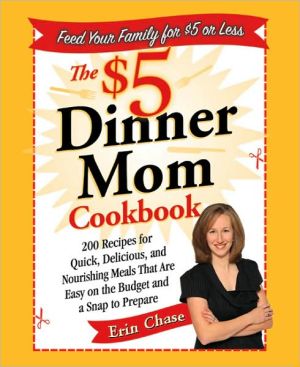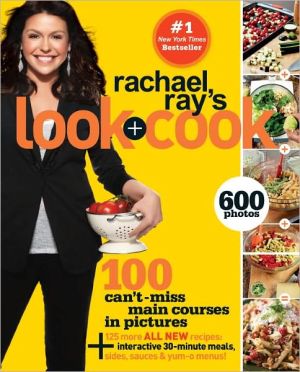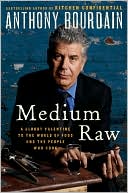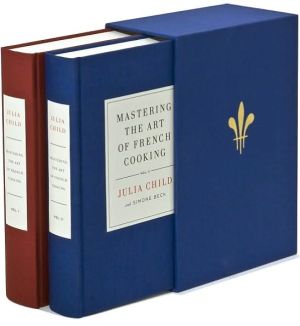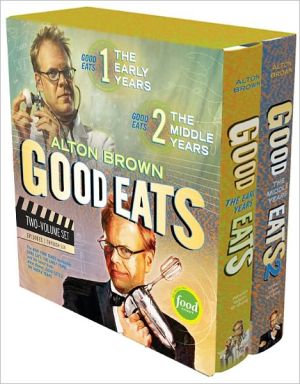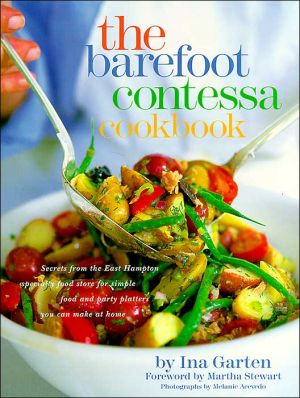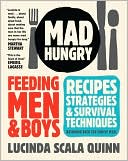The $5 Dinner Mom Cookbook: 200 Recipes for Quick, Delicious, and Nourishing Meals That Are Easy on the Budget and a Snap to Prepare
Do you wish you were a savvy supermarket shopper who knows how to cut your weekly food budget, banish fast food from the dinner table and serve your family meals that are delicious and good for them? Well, Erin Chase, "The $5 Dinner Mom", is here to help.\ Erin is the founder of www.5dollardinners.com the skyrocketing internet website that's now the go-to source for families who want to eat well and stay within a budget. Erin became a supermarket savvy mom, challenged herself to create...
Search in google:
Do you wish you were a savvy supermarket shopper who knows how to cut your weekly food budget, banish fast food from the dinner table and serve your family meals that are delicious and good for them? Well, Erin Chase, "The $5 Dinner Mom", is here to help. Erin is the founder of www.5dollardinners.com the skyrocketing internet website that's now the go-to source for families who want to eat well and stay within a budget. Erin became a supermarket savvy mom, challenged herself to create dinners for her family of four that cost no more than $5 and is here to share her fool-proof method with you in her first cookbook that contains over 200 recipes that cost $5 or less to make. First, Erin will show you how to size up the best supermarket deals, clip coupons that will really save you money and create a weekly dinner menu plan. Then, in each recipe she shows you just how much she paid for each item and challenges you to do the same. Here are a few of her favorites:- North Carolina Pulled Pork Sandwiches - $4.90- Curried Pumpkin Soup - $4.41- Apple Dijon Pork Roast - $4.30- Orange Beef and Broccoli Stir-Fry - $4.94- Creamy Lemon Dill Catfish - $4.95- Bacon-Wrapped Apple Chicken - $4.96- Country Ribs with Oven Fries - $4.77Join the army of devoted followers who have already let Erin Chase show them how to be savvy supermarket shoppers who cook tasty, economical meals. You'll never spend more than $5 on dinner again. Library Journal This debut cookbook by the creator of the popular family-food-budget web site www.5dollardinners.com presents 200 recipes for meals that cost $5 or under to make. In her introduction, Chase discusses how to spot a good product deal, create a weekly food budget, use coupons, stockpile large quantities of a sale item, and plan meals. Recipes include dollar breakdowns for each ingredient as well as total meal cost, frugal facts (e.g., corn usually goes on sale during the early and late summer), and easy-to-follow instructions. Appendixes include essential kitchen gadgets, pantry necessities, and coupon web sites. This one-of-a-kind book, which mixes thrifty shopping tips with recipes, is sure to be a hit with library patrons, especially those who saw the author on Rachael Ray's show, and every cook on a budget.
$5 DINNER MOM COOKBOOK\ ONEStrategic Grocery ShoppingHere is where I'll share how I went from "just getting groceries" and spending more than $500 a month to really saving money on my groceries and spending less than $300 a month. The strategies outlined in the following chapters all play an important role in making the most out of each trip to the grocery store and, of course, they are essential to making $5 Dinners.Before I get into the temptations and obstacles that are thrown my way every time I go to the store, I'd like to share with you what kind of shopper I used to be, and what kind of shopper I am now. \ \ Shopper Profiles \ I used to be the kind of shopper who just went to the store and did all that I could to keep the children entertained and happy. I paid little attention to what I added to the cart. I just wanted to make sure there would be enough food to last until the next week, when we'd load up the car and do it all over again. I was happy to see thesale tags on some of the products that I purchased each week, but did not seek out sale items or use coupons.Although I wouldn't call myself an "Impulse Shopper," I certainly wasn't being smart in my grocery spending. I knew that I could do better. I wanted to become a "Savvy Shopper."I wrote up a little quiz that will help you determine what kind of shopper you are. It's a quick ten questions that will help you think about your grocery shopping and spending habits."WHAT KIND OF SHOPPER ARE YOU" QUIZAnswer the following questions to determine what kind of shopper you are:1. When it comes to the grocery store circular, I ...a. Don't know where to find it or when it comes out.b. Toss it out with the rest of the newspaper ads.c. Review it each week to see what is on sale at my grocery store.2. In my family, the grocery budget is ...a. A free-for-all. No care or attention is paid to how much is spent at the store.b. Loose. But I know I'm spending too much money each week.c. Tight. I know exactly how much I have to spend each week.3. When I go through the grocery store, I ...a. Grab what I think I need or might use and get out of there as fast as I can.b. Have a list, but still find myself buying eight items not found on my list, as I just can't help but grab a box of donuts and bag of chocolate.c. Have a list, a stack of coupons, and only get what I need each week.4. I use coupons ...a. Never. I don't have time or energy to devote to couponing.b. Sometimes. I use them for a few products on my grocery list.c. Always. I plan how I will use my coupons, and try to use them only when the product is already on sale.5. I am willing to sacrifice quality and taste to save money.a. True. I simply can't afford the highest-quality items in the store.b. False. I would rather pay a little more for higher-quality ingredients.c. False. I still buy the same great quality products, but only when they are on sale.6. The thought of taking my children with me to the grocery store makes me want to ...a. Shrug. Doesn't bother me at all to bring the kids along.b. Pout. I wish I didn't have to take them with me, but I don't have a choice.c. Cringe. I would never take my kids with me to the grocery store. They always make me spend more money than I want to.7. When I see a fantastic sale price for my favorite product, I ...a. Don't seem to notice that it's on sale.b. Grab several boxes and add them to my cart.c. Will hunt down coupons so that I can replenish my stockpile.8. Meal planning is something that ...a. I've never heard of or thought of doing.b. Happens on occasion, but doesn't seem to be a consistency in my house.c. Occurs every week in my kitchen.9. If I see a product on "super sale" at a grocery store where I don't typically shop, I ...a. Have never thought to compare prices at other stores.b. Am glad that I have an appointment nearby that store later in the week, so I can stop in to buy it.c. Would drive out of my way just to get the great deal because I need to get more of that product.10. The cashier hands me my receipt and says, "Thanks for shopping with us today, your total savings were ..." What is the percentage of savings?a. 0%b. 25%c. 60%Total # A's __________ Total # B's __________ Total # C's __________QUIZ RESULTSIf you answered mostly A's, then you are an "Impulse Shopper."If you answered mostly B's, then you are a "Decent Shopper."If you answered mostly C's, then you are one "Savvy Shopper." \ My Quiz Results: Before the summer of 2008, I would have classified myself somewhere between an "Impulse Shopper" and a "Decent Shopper." Since discovering and implementing the following strategies and learning to be more disciplined while in the store, I declare myself a "Savvy Shopper."Temptations and Obstacles in the Grocery StoreA savvy shopper understands the temptations and obstacles within the grocery store, and comes armed and ready to fight. I had to learn about the many stumbling blocks found through the aisles of the grocery store. I had to learn to spot a real deal and a fake deal. And I had to learn the common marketing tactics that manufacturers and grocery stores use to get consumers to buy more products. Let me share an overview.First, I want to share a little about what I call, "Sensory Overload—Grocery-Store Style." At first I misclassified this as "reverse grocery store culture shock." After so many years shopping in Dominican Republic grocery stores, I was not used to the culture of the American grocery stores. Upon re-entry into the American culture, I found myself in "reverse culture shock," both in life and when in the grocery store. My first few trips to the grocery store in the U.S. were overwhelming. Not just the one-hundred choices of toothpaste, but the sights and smells that floated through the air. It was almost too much for my "third-world brain" to take in.It took me many months to realize that this sensory overload was not going anywhere. I had grown accustomed to the number of choices in the store and the reverse culture shock had worn off. But the sensory overload remained. Have you ever noticed how intense and bold the sights and smells are when you walk into the grocery store? In the summer months, I can hear the flowers in store's entryway shouting, "Buy Me. No, pick me. Hey, look at my pretty petals." And then I walk through the doors, right past the ginormous table of pies and cookies. Geesh! I don't know how much more of this I can take. Next, I stroll right on past the floral department, admiring what could be that week's centerpiece on my dining room table, and head through the produce department picking up bags and bags of fresh produce, only to find myself next to the bakery. I can smell it from the potatoes. It just has that powerful luring effect. The donuts and cookie cakes cry out for my attention as I speed on by. It's tempting, it really is!I manage to make it to the other end of the store, only to find that the in-store homemade potato chip-making machine is in full gear, cranking out the most delicious and fresh-tasting chips known to man. Or at least known to me. Knowing that they were made right there from real potatoes somehow makes them healthier. But it's the smell that gets me every time. The smell of fresh fried potato chips ... mmmmm.I've had enough of these fabulous sights and smells. I have got to get out of here before I run back for that floral centerpiece, a dozen donuts, and seven bags of homemade potato chips. I remind myself that I only have $60 cash and I don't have enough for such luxuries. I've almost made it!Finally, it's time to check out. Whether I just popped into the store for bananas, eggs, and milk, or I have a cart full of groceries, the final battle takes place in the checkout line. This one is the toughest for me to fight because I'm a sucker for celebrity gossip and chocolate. I'm losing the battle before I even walk into the line. Focus. Focus. Don't read the headlines. Get your coupons ready. Do something other than stare at the chocolate bars or pick up that magazine. But come on, I just want to know what's happening with Brad and Angelina this week! Thankfully there is no line and I don't have to stand waiting and fighting the chocolate and gossip temptations.GROCERY STORE MARKETING STRATEGIESNow that I've walked you through the grocery store from my vantage point, let's talk specifics as far as grocery store marketing tactics. There are some other important marketing strategies that grocery stores use to better display and market the products for sale. A major marketing strategy used by grocery stores is the endcap. The endcap is the set of shelves at the end of the aisle used to display popular items that are on sale that week. The purpose of the endcap is to allow the customer to grab the sale item while they walk down the main aisle without having to walk allthe way through the middle aisles looking for the item. But I have discovered that the prices on the endcap products are not always the best price for that product. It may be on sale, but there may be other cheaper options down the aisle. The store wants you to buy the more expensive product, even if the product is technically on sale. The products on endcaps are attractive, but might not be the best bargain.A second strategy that grocery stores utilize is strategically placing specialty items in the middle of the aisle so that customers have to walk past other commonly purchased items to find the specialty item. I will use the example of the coffee in my grocery store. The coffee is located in the middle/back of the "drink" aisle. On the way to grab a bag of coffee, customers must go past the bottled water, juices, and chocolate syrup. On the way back out of the "drink" aisle, many customers' carts will have a case or two of bottled water, a jug of fruit juice, and a bottle of chocolate syrup. Even though they intended on grabbing one bag of coffee, they ended up with water and acai berry juice to go with their chocolatey mocha for breakfast.A third marketing tool that manufacturers utilize is the "eye-level" strategy. Companies pay a premium to get their products displayed at "eye level" so that customers will see them first and add them to their cart. The problem for the customer is that the premium that the companies pay is reflected in a higher price for the product. When looking for the better deal, look high and low for similar products that cost less.A fourth, and very potent marketing tool for any grocery store is the "location tool." Location, location, location. What are the three most common items that people run into the store to grab? Bananas, milk, and eggs. And where are these products located? In my grocery store, they are located in three opposite corners of the store. That is not random. The purpose of this is to get customers to walk through the entire store for their three items. Inevitably, the customer will pick up two to nine other items along the way that they don't need. Think about that next time you have to run into the store for bananas, eggs, and milk.The store did its job. It enticed me into purchasing more than I intended to. But I did my job as well. I did not fall for such temptations and I stuck to my budget and my list. With a little practice and discipline, I have learned not to succumb to these strategies. The temptations and obstacles will always be there, but as long as I remember to stick to my list, I won't come up short on change at the cash register.Victory!How to Get the Most for your Time and Money at the StoreSo I figured out how to resist the temptations and obstacles while browsing through the aisles, but it came time for me to put my own consumer strategies into play. I needed to figure out how to get in and out of the store as fast as possible, spending the least amount of money. I needed a plan.STORE CIRCULARSStore circulars are released each week, letting shoppers know what is on sale in the store that week. Each store arranges their circulars in a different way, but one feature is consistent across the board for all grocery stores; the products with the best sale prices will be on the front page of the circular. These products are called "loss leaders." A loss leader is a product that is on sale at such a low price that the grocery store will take a loss on the sale. By advertising popular products for at cost or below cost prices, grocery stores can entice consumers to come into their store. The word "leader" in the phrase indicates that once the consumer is in the store to get the great deal, they will be led to purchase other groceries, which will in turn make up for the profit loss on the loss-leader product.Prices in the store circular, and especially on loss-leader products, are often listed as follows:I DOZEN EGGS, 10/$10, OR 10 FOR $10This does not mean that I have to purchase ten dozen eggs to get this great price of $1/dozen. This is a gimmick that stores use to encourage consumers to buy more than what they really need of products that are on sale. I would just buy one or two dozen at this price to last for a week or two. I have spoken with many consumers who assumed that 10 dozen had to be purchased to "get the deal."Loss leaders can certainly be alluring. It would take an amazing bargain to get me to drive out of my way to get a product from somewhere other than my normal grocery store. It happens on occasion, but I am sure to only buy that one product that drew me into the store. I will not be tempted by other deals I might spot in the other store. I am there for one reason and one reason only. That specific loss-leader product.Once I decide which loss leaders are worth buying each week, I continue looking through the circular circling items that I need to buy for the week. I will look at the different cuts of meat that are on sale and decide if I should write a meal using thatmeat into my weekly meal plan, or if I should buy a few extra packages and "stockpile" them in the freezer. Once the best deals have been marked, they are added to my grocery list.When it comes time for matching coupons with sale prices, store circulars are crucial. After I've circled all the products that I'm interested in purchasing, whether because of the sale price or the need for the product, I go back through the circular to look for coupon matches. By using coupons when the product is on sale, I can maximize my savings in the store. (More on this in chapter 2.)Another way to use the store circular is to track sale prices and keep a record of them in a price book. I like to call this list my "never-pay-more-than" list. I created this list over time, and make updates to it when necessary. I began keeping track of the prices of my favorite meat cuts and fruits and vegetables, since their sale prices can fluctuate throughout the seasons and sale cycles. Paying attention to these prices allowed me to come up with a sale price that "was worth paying." Some sale prices are just pennies or dimes below the original retail price. While this does help save here and there, it doesn't typically make a large impact in the savings percentage. My "never-pay-more-than" list helps me keep track of my favorite products and when they go on sale for 40 to 50 percent off their original price.Here are a few examples from my "never pay more than" list. Please note these prices are sale prices with coupon matchup, if applicable.• Fresh strawberries, blueberries, raspberries $1.50 a pint or quart• Frozen vegetable bags (16 ounces.) - $.88• 10-pound bag of potatoes - $2.99• Sweet potatoes - $.88/pound• Canned tomatoes (15 ounces) - $.59• Olive oil (25.5 ounces) - $5.99• Diapers - $8.99/Jumbo pack• Antibacterial hand soap - $.30/bottle• Shampoo - $1/bottle• Toothpaste—Free! By matching a $1 coupon with a $1 sale price, toothpaste can often be purchased for free. \ \ I also add to my "never-pay-more-than" list after shopping trips. Because what is in the store circular is only about one-third of what is actually on sale in the store, I often find other great deals that I didn't know about going into the store. I will quickly jot down the price (if I don't buy it and have record on my receipt) and add it to my "never-pay-more-than" list when I get home.By analyzing and planning my grocery trip with the store circular, I can save both time spent in the store, as well as money in my pocket. But, there are a few other essential tools I use to make it out of the store "under budget."MAKING THE GROCERY LISTEach week I create a shopping list. I need a list for two reasons, the first being that I will forget something that I need if it's not written down (yet, strangely my brain remembers the prices on products!). The second is that I want to buy only what I need for that week. My budget doesn't allow for impulses and randomly adding products to my cart. I have learned that having a list is essential for saving money at the grocery store.I make my grocery list based on sales in the store circular, my weekly menu plan, and what I already have stored in the cupboards, refrigerator, and freezer. My list always includes milk, yogurt, eggs, apple juice, fruits, and vegetables. After those few items, the list varies week by week, depending on the sales and my menu plan.Making a list and sticking to it will also prevent those quick trips into the grocery store for a single ingredient that inevitably turns into a mini shopping spree. Occasionally I will come up short an ingredient, but I like to think of it as "part of the fun." It gives me an opportunity to be creative with ingredient substitutions while cooking.If I don't have taco seasoning mix, I can substitute it with spices like ground cumin, chili powder, garlic powder, and onion powder. I often find myself out of butter on a night when I'm making mashed potatoes. I have discovered that olive oil is a lovely, and healthier, substitute for the butter. When I'm out of BBQ sauce or Sloppy Joe sauce, I can make my own using ketchup or tomato sauce, mustard, brown sugar, and a few spices. By utilizing what I already have on hand, I can save myself those few extra dollars each time I "need" to run back to the store for just one ingredient.CASH AND A CALCULATORThe question remains ... how do I actually stay within my budget? What practical tools do I use to accomplish this task? I've got my grocery list and my stack of coupons, but there are two items that help me stay accountable to my budget each week. \ 1. A calculator2. Cash \ Yep, that's right. I carry a calculator and cash only. No "plastic" allowed in the grocery store. I used to be able to keep a running total in my head as I went through the store, but I have found that a calculator is much more effective and less stressful. Because I have a finite amount of money in my pocket, I can't go over budget. I have to keep track of how much I will be spending. My state does not have a sales tax on food, so I typically can run right up to my total budget without worrying about going over because of sales tax.I even did a little plastic-versus-cash experiment. My credit card offered five times the "points" for purchases made at the grocery store. I thought, What if I make use of my credit card to buy a $300 gift card to my grocery store to use each month? That way I have a "finite" amount of money to spend at the store, plus I got five times the "points" on my credit card.I tried this method for two months. I did not go over budget and spend more than my gift card during either month. But I did find that my "plastic" mentality still existed each week. Well, I could just get a few more things and just spend less next week. Or, I really should get an extra bag of flour, even though it's not on my list, because I know we' ll need it. It's OK if I go over my $60 for this week.That plastic mentality left me with just $25 to spend the last week of the month, during both months. That really wasn't enough, but I was left to plan meals based on what I had on hand from previous shopping trips. It left little room for "stockpiling" sale items those weeks because I had not been disciplined enough in previous weeks.After my experiment, I settled on cash and a calculator. I could not show up at the cashier with $82 worth of products and only $60 in my pocket. Using cash forced me to be disciplined in my spending and challenged me to be more creative with my meal plans.Now, when I go to the grocery store, I carry only what will fit in my pockets plus my coupon binder. I typically have my list with the coupons that I already pulled out, a pencil, my cash, and my car keys with the store loyalty card. Oh, and my trusty little calculator. (Wouldn't my calculus teacher be proud!)PRODUCT MARKDOWNSI have asked at one time or another every department manager about product markdowns. Dairy, meat, produce, deli, bakery ... they all know me! And no, they don't run and hide when they see me coming. I like to ask about product markdowns. \ • Is there a certain day of the week that your department marks down products for quicker sale?• Is there a time of the day that is better for getting the best selection of marked down products?• Where can I find marked down products? Is there a specific location in the department to find these markdowns? \ My store has this bright red sticker that says, MANAGER'S SPECIAL. This sticker is added to products that are marked down so they can be sold before they "expire." The stickers are also used on products that have not sold fast enough in the store.I have found these stickers on everything from baking powder to milk to bags of snap peas and coleslaw. I find them regularly on bakery items and fresh meat products. My grocery store even has a section in the meat department devoted to the packages that have been marked down, as well as a shelf at the back of the store with markdowns on non-perishable items. I scan through the marked down products to see if there is anything I can squeeze into my budget. If I have coupons in my binder for the products, it's a double bonus.Another product to look for with markdown stickers is milk. Seriously? Yes, seriously. I have seen half gallons of milk priced as low as $.25. Milk can be found on markdown and used up right away. It can be used to make homemade yogurt, a large batch of homemade waffles for the freezer, a pot of creamy soup, or homemade basic white sauce.When looking for markdowns, I always check the quality of the product, as well as the original price. Occasionally markdown prices are just dimes less than the original retail price. Although every penny counts, it's sometimes not worth purchasingif I know I can't use or freeze the product right away, or if it will push me over my weekly budget.ANATOMY OF THE SHELF TAG—UNIT PRICING AND SALE DATESPaying close attention to prices is essential to saving money. When making bulk purchases and buying products that I know we will use up quickly, I carefully check the unit prices on the different-size containers or bags of the same product. The shelf tag typically lists a unit price, per ounce or per individual item, depending on the product. I like to buy "in bulk" products like laundry detergent, dish soap, dishwasher soap, bags of rice and pasta, as well as certain condiments, and olive oil. I always choose the size with the lowest unit price, which is typically the largest package for that product. I am careful to check the unit prices on sale items, because sometimes a medium-size package that is on sale is much cheaper than the larger "bulk" package. Checking unit prices helps me stretch my dollars as far as possible.My grocery store also has a "sale expire" feature listed on the sale tag. Not only is the sale tag brightly colored and flashy, it also lists how long the product will be on sale. There is a "sale expires" date on the sale tag. This comes in handy on weeks when I just don't think I can squeeze that particular product in and stay under budget. Knowing that the product will be on sale for another two weeks, I can add it to next week's list without stressing that I "missed a good deal" on a great product. I know of two other grocery stores in my area that have sale dates on their tags. I suggest asking the customer service desk if your store has a similar feature.MULTIPLE STORE SHOPPINGLike I mentioned before, I typically don't shop at more than one grocery store in the same week for one reason: proximity. I live very close to the grocery store in my neighborhood and all the other grocery stores are at least 15 minutes away. There is a shopping center about fifteen minutes away from my house that has four (yes, four!) grocery stores all in a row. That is a bargain shopper's dream. To be honest, I'm a little jealous of my friends who live close to this grocery store "central".But would I really save money by going into more than one store each week? Knowing myself and my propensity to stick to my grocery list, yes, it would be worth going into more than one store. If you are not inclined to stick to your list, then shopping at multiple stores might not be such a great money-saving strategy.Let me share a practical real life scenario using this shopping center with four grocery stores in my town. The center includes two regular grocery stores, one discount grocery store, and a "big box" grocery store. A discount grocery store is defined as a store that sells only generic or store brand products. A "big box" grocery store sells both groceries and all types of other household goods, clothing, and toys.Here is a potential weekly shopping list and sale prices for each store.Store A2 acorn squash ($.69) 4 pounds bananas ($.25/lb.) 1 watermelon ($2.50) 4 canned tomatoes ($.59 each)Store BPeaches 3 half-gallons milk ($.75 each) 2 loaves bread ($1.25 each after coupon) BBQ sauce (free after coupon) 5 yogurts ($.33 each)Store CSweet potatoes ($.49/lb.) 4 packages (about 6 pounds) boneless, skinless chicken breast ($1.66/lb.) One 6-ounce package delimeat ($1.50 after coupon) 4 Rice Krispies cereal ($1/box after coupon)Store D2 packages (about 3 pounds) ground chuck ($1.79/lb.) 4 broccoli ($.88/bunch) 12-ounce sour cream (free after coupon) 4 bags shredded cheese ($1.50 each) \ Total Spent at all 4 stores: $44.97This is a typical grocery list for me. A few of the items are "stockpile" items like the cereal, chicken breasts, ground chuck, broccoli, shredded cheese, and canned tomatoes. I will stash them away in the freezer or cupboard for use in future meals. I willalso use other items that I purchased in previous weeks when making meals that week.Because these stores are so close together, and because I would not be shopping with my children, I can run in and out quickly, getting just the few items from each store. If I had simply gone to my regular grocery store for the same items, I might have spent $15 to 20 more for this exact same list, as not all the products would be on sale.For now, I will stick with my strategies at my neighborhood grocery store and save myself the 30 minutes driving time, as well as gas mileage ... and dream of other grocery stores moving into my area.DECIDING ON A WEEKLY GROCERY BUDGETWhen coming up with an amount of money for the grocery budget, I encourage others to track spending for a few weeks, or even months. Then apply several of the strategies discussed here to see how much you can lower your grocery bill. With a little practice and tracking the savings, a "doable figure" for the weekly grocery budget will become evident.When I first started on this journey to saving money at the grocery store, I averaged about $125 to 150 a week. Once I started paying closer attention and put these strategies into play, my grocery bill came down every week. After a few weeks, I noticed that my weekly total at the grocery store averaged around $60. Some weeks I spent a little more than $60, and other weeks I spent less. That figure became my weekly spending goal.I have made exceptions to this figure, depending on life's seasons. For example, during the first trimester of my third pregnancy, I raised my weekly goal to $80. And for two or three weeks, I spent $100 for the week's worth of groceries. It was all I could do to simply get myself through the store, thanks to the fatigue and nausea. Couponing and bargain shopping were put on hold, until I came through that short season. After a few weeks of giving myself a break, I was back to my $60 a week budget. Exceptions must be made during times like these.So what happened to that $65 to $80 a week savings? For the first few months, that savings was simply keeping our budget in the black, as the gasoline prices were still sky-high. But as the gasoline prices came back down and we weren't spending $500 a month to get around town, we began allocating the savings to a vacation fund and to college funds for the kids. Knowing that we could go on vacation with a little extra breathing room was motivation enough for me to keep on saving andkeep on with my savvy shopping. Whether our monthly budget is tight or not, I will continue to put these strategies to good use and stash away the money saved at the grocery store into a college fund, trust fund, or vacation savings account.By utilizing these strategies while in the grocery store and by overcoming the many temptations and obstacles found throughout the store, I now stay comfortably within my grocery budget each week.There are many other strategies that come into play that help me save money at the store. The next set to be discussed is the couponing strategies. Get your scissors ready, because it's time to start clipping!THE $5 DINNER MOM COOKBOOK. Copyright © 2009 by Erin Chase. All rights reserved. For information, address St. Martin's Press,
Acknowledgments ixIntroduction xi1 Strategic Grocery Shopping 12 Strategic Couponing 163 Strategic Meal Planning 334 Pasta and Pizza Dinners 515 Chicken and Turkey Meals 876 Beef Meals 1317 Pork Meals 1658 Fish and Seafood 1919 Soups and Stews 20710 Vegetarian Meals 23111 Homemade Recipes 257Appendix A 287Appendix B 291Index 293
\ From the Publisher"Erin's $5 Dollar Dinner approach is ideal for my family—her recipes are simple, healthy, delicious and always affordable. She proves that budget cooking does not have to be boring!"—Stephanie Nelson, author of The Coupon Mom's Guide to Cutting Your Grocery Bills in Half\ \ \ \ \ Library JournalThis debut cookbook by the creator of the popular family-food-budget web site www.5dollardinners.com presents 200 recipes for meals that cost $5 or under to make. In her introduction, Chase discusses how to spot a good product deal, create a weekly food budget, use coupons, stockpile large quantities of a sale item, and plan meals. Recipes include dollar breakdowns for each ingredient as well as total meal cost, frugal facts (e.g., corn usually goes on sale during the early and late summer), and easy-to-follow instructions. Appendixes include essential kitchen gadgets, pantry necessities, and coupon web sites. This one-of-a-kind book, which mixes thrifty shopping tips with recipes, is sure to be a hit with library patrons, especially those who saw the author on Rachael Ray's show, and every cook on a budget.\ \
